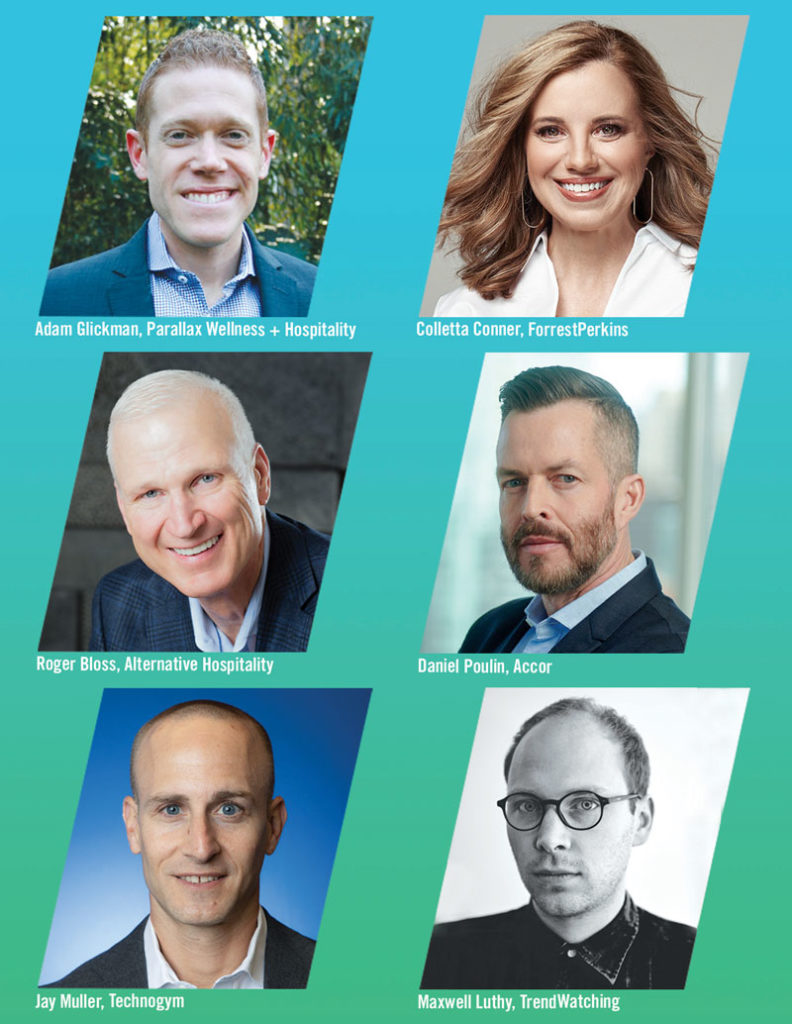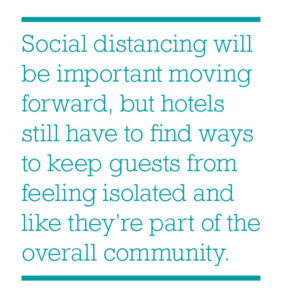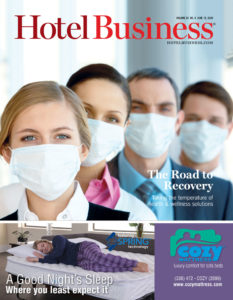 NATIONAL REPORT—During the inaugural Grounded by Design virtual event, “Designing for the Wellbeing of Travelers Post COVID-19,” hosted by NEXT Events in partnership with InspireDesign, Hotel Business and Parallax Wellness + Hospitality, and sponsored by Decolav Hospitality, industry professionals gathered to discuss the state of hospitality design, providing insight into what the future of hotel design and operations may look like.
NATIONAL REPORT—During the inaugural Grounded by Design virtual event, “Designing for the Wellbeing of Travelers Post COVID-19,” hosted by NEXT Events in partnership with InspireDesign, Hotel Business and Parallax Wellness + Hospitality, and sponsored by Decolav Hospitality, industry professionals gathered to discuss the state of hospitality design, providing insight into what the future of hotel design and operations may look like.
Moderated by Adam Glickman, principal, Parallax Wellness + Hospitality, he began the session by asking: How will design change to fit this new normal? Although no one can predict the future, Glickman acknowledged that the industry can consider scenarios to figure out how to best manage business.
“This is the time to be very open-minded, to have discussions, to ask questions and collaborate,” said Maxwell Luthy, director of trends & insights of TrendWatching’s North America office. “I think what’s going to be really important is the airlock feeling of stepping into a safe and secure space. Whether designers convey that with temperature, with sound, with light, with smell, it’s beyond the systems that actually keep a hotel or resort clean and clear. I think around the perimeter it needs to have that feeling of when you do step inside, this is safer and cleaner than what’s outside these doors.”
Luthy mentioned that for hotels—specifically, sustainability-focused hotels—it’s far more eco-conscious to adapt spaces to meet these needs post-pandemic, rather than building out new infrastructure. Adapting these spaces often means putting new programs or services into place for guests, hardly altering a hotel’s structure.
“It’s going to come down to budget on a lot of projects, so I think that there’s going to have to be an appetite for it before we see any growth. Big changes come in the built environment,” said Colletta Conner, studio leader of ForrestPerkins’ Dallas office.
Luthy added to this, noting that guests’ comfort extends far beyond what’s visual.
“Beyond just the physical infrastructure, the surfaces, the air quality and the spacing of the guests, something that’s kind of been hinted at here—and I think it’s going to be incredibly important—is the health and safety of the staff and the employees as well. This has been a longer-term trend,” Luthy said.
According to Jay Muller, VP of hospitality—North America, Technogym, projects already in the pipeline aren’t really being impacted by the COVID-19 outbreak, just adjusted.
“For those [projects]in the near term, we’re not having any discussions about changing anything. These things are fully baked, electrical has already been planned, special planning has already been set. One of the things we are talking about with prospects and customers is asking for more [fitness]space,” Muller said.
Muller said that he fully expects guests to yes, want to workout in the privacy of their own guestrooms, but also have ample space to practice social distancing should they choose to use the hotel’s fitness facility.
“We think there’s going to be a real shift to connecting and engaging everywhere,” Muller said. “Workout walls with QR codes more reliant on their phones; contactless, motion-activated sensors to avoid door handles; embedded wakeup on machines; I think technology will be leading the charge.”
Others shared this sentiment, and even believe that guests will welcome these types of changes.
“Research has shown that consumers don’t mind biometrics when it helped with their security,” Luthy said.
Roger Bloss, CEO of Alternative Hospitality, a division of MJ Holdings Inc., recognized that the industry and its approach to design are evolving, but he’s committed to adhering to safety measures without sacrificing experience.
“I’ve looked at this as a whole lifestyle, not as a job, not as a vocation; it’s just been something that’s part of my DNA and culture,” Bloss said.
 kBloss also believes the hotel industry will adopt this kind of technology along with social-distancing practices that don’t feel forced, especially with F&B and amenities.
kBloss also believes the hotel industry will adopt this kind of technology along with social-distancing practices that don’t feel forced, especially with F&B and amenities.
“We have artificial intelligence, we have facial recognition so they don’t have to touch these machines and they’ll see that they can disperse these on a much wider scale without a lot of labor, and people would be very comfortable with that throughout. It also gives you that 24-hour option within your facility,” Bloss said.
As for social distancing, Bloss believes that pool design will change, offering other options like lazy rivers for natural separation. He also said hotel leaders may welcome ideas of having smaller food and beverage stations throughout a public space, still maintaining spacing concerns without making people feel isolated.
“We’ll see things are going to make people inclusive,” Bloss said. “Changing the pool design and the pool bars, things of that nature…So, we see that just by creating this design that will automatically give the spacing that we need, but people won’t feel that way.”
Bloss also expects more self-serve and vending machine options to limit human-to-human contact.
“It’s kind of old school, but yet I think people are going be really comfortable with it,” Bloss said. “I think there’s also going to be some government standard set. I expect AHLA to come out with certifications along with AAHOA. I think they’ll be done state by state.”
According to the survey, “Wellness in a Post-COVID World,” commissioned by Vital Vio (creators of antimicrobial LED technology), when COVID-19 fades away and the travel industry encourages consumers to come back, 40% of Americans say they will only go to public spaces when necessary. This, however, could have other implications.
“There’s a lot more research in the last few years from sites that have proven that loneliness is the equivalent of smoking 15 cigarettes per day,” said Daniel Poulin, director, spa & fitness, North & Central America, Accor. “So, are we going to start building larger facilities, which nobody has the money to do, that are all somewhat divided into small areas where people are almost alone, participating in a wellness program that normally they would do as a group? And, what is the impact of this isolation and loneliness to the overall health of the community?”
Poulin believes that however hotels decide to tackle these concerns, they can’t lose that sense of community. Connection to location and culture are major draws for a property, so hotels may need to find ways to creatively engage while also staying safe.
“I think it’s a combination of how we adapt our operations in order to perform cleanliness,” Poulin said. “Something that we used to keep back of house or in private that we don’t want the luxury guest to see, this is all going to be changed and adapted. We’re all going to be doing a theatrical performance in front of the guest to show that this is an environment that has been sanitized and is welcoming.”
Conner said that other options are available with more behind the scenes work. This includes ensuring HVAC systems are functioning properly, offering new product lines from designers with antimicrobial features and making sure that staff are trained on proper cleaning materials and solutions.
“Hotels need to be better at cleaning hotels,” Conner said. “One of the first touchpoints that hotels can provide to guests is the option of self-disinfectant and self-sanitizing. Not everyone is going to walk through the door with that and those are probably the ones that need it the most.”
According to the Vital Vio survey, more than half (56%) of Americans are willing to pay more for a travel service that incorporates enhanced cleaning tools to regularly disinfect spaces. And, 82% of consumers are also now more aware of/concerned with cleaning tools and protocol in public spaces.
“Brands should engage the experts in order to get the right product and the right processes in place,” Conner said.
Most of those surveyed expect to see physical changes in areas like the public availability of hand sanitizer (92%), increased cleaning staff (78%) to protect consumers and an investment in cleaning technology (61%) such as disinfecting lights and cleaning robots.
“A huge part of what we’re talking about here moving forward is giving a sense of wellbeing—not just physical wellbeing but mental wellbeing,” Conner said. “Some of those things are the first line of defense that we can offer to guests to see that they have the ability to take care of themselves in any way that they choose.” HB
Check out our video coverage at video.hotelbusiness.com

